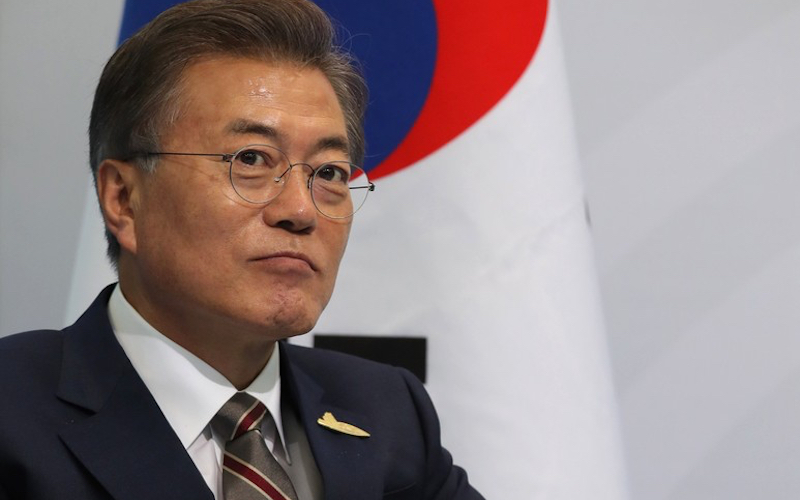
Seoul’s Final Countdown on North Korea
Faced with the escalating threat of imminent attack from an increasingly unstable and war-obsessed North Korea, Japan last week asked Washington for help in deploying the U.S. Aegis Ashore land-based missile defense system in a bid to shore up its defenses against a potential missile strike. Nervous about the unpredictable behavior of a rogue state willing to risk nuclear war, Tokyo believes the technology would greatly improve its chances of shooting down a ballistic missile launched by Pyongyang before it arrives anywhere near Japan’s coastline.
The request came following an August 19 meeting held by U.S. and Japanese defense ministers, during which officials pledged greater defense cooperation between the two nations, and “unwavering U.S. commitment to extended deterrence” in the face of Pyongyang’s growing brinkmanship. At the same time, Japanese officials stated the country would seek to expand its role within the alliance by increasing its defense capabilities.
Such signaling of unity between Washington and Tokyo is a welcome show of force indeed. When Trump entered the Oval Office, concerns about his continued commitment to the U.S.-Japan alliance abounded, making Japanese Prime Minister Shinzo Abe the first head of state to rush to Washington to meet Trump. Since then, far from freezing over, relations between the two countries have strengthened over recent months. Not only did they demonstrate military resolve by holding joint military drills, they furthermore leveraged their diplomatic power to persuade China to approve a punitive UN resolution pressuring Pyongyang into abandoning its nuclear weapons program.
Strong bilateral ties have thus proved a vital pillar of stability at a time when dealing with North Korea has become particularly difficult – no less because of the disarray in the White House. Recently, contradictory remarks about response plans to North Korea’s threats from Trump and leading administration officials have injected considerable instability into U.S. Korea policy. The subsequent mixed messaging regarding whether a military strike against North Korean nuclear installations was off the table or not, only served to heighten the sense of confusion about the direction of Trump’s Korea policy.
Without a doubt, the ensuing ominous sense of insecurity has emboldened Kim to become ever more bellicose with every passing day. Responding to joint U.S.-South Korean military drills taking place in the region, Kim this week warned the exercises could lead to an “uncontrollable phase of a nuclear war.” However, throughout the duration of the current crisis, the alliance between America and Japan has remained steadfast, as the U.S. and Japan have led efforts to contain the threat posed by Kim Jong-un.

In contrast, South Korea’s response to its neighbor’s posturing has done little to further collective efforts to rein in Pyongyang. In fact, Seoul’s reluctance to take a firm stance on the Kim regime has only contributed to the region’s insecurity, since South Korean President Moon Jae-in’s policy of pushing for engagement has been directly at odds with Tokyo’s and Washington’s drive to isolate Pyongyang. Since taking office, Moon has offered a series of concessions to Kim’s regime in exchange for talks, and his latest suggestion to send a special envoy to North Korea to negotiate an end to the nuclear program is but the tip of the iceberg. No wonder that a running joke in the streets of Seoul is to refer to Moon as a “communist.”
What is worse is that Moon’s policies have had the net effect of straining relations with Japan, which Pyongyang has singled out as a target for its nuclear arsenal. Particularly, strong criticism of the arduously attained, and thus regarded “irreversible” 2015 Comfort Women Agreement between the two countries, drew much ire from Japan. The agreement obliged Tokyo to apologize for Imperial Japan’s war conduct, and to establish a foundation paying restitution to the surviving comfort women. But with Gender Equality Minister Chung Hyun-back’s announcement to review the foundation’s activities and even threatening to break it up, the agreement is effectively upended. This development does not bode well for the prospect of the two countries being able to work amicably together on a solution to the North Korea crisis.
Unfortunately, time is running out for the region and for agreeing on a common, coordinated strategy among Washington, Japan and Seoul. In fact, South Korea continues to be out of step. Promising that the Korean Peninsula will not see another bloody conflict, Moon last week half-heartedly warned Pyongyang “not to cross the red line.” Not only do such vague and abstract statements merely put South Korea in the backseat as the U.S. and Japan are stepping up their efforts; but with North Korea’s recent missile tests demonstrating the ability to strike the U.S., coupled with threats to attack Guam, it has become abundantly clear that any such red line has already been well and truly breached weeks ago.
Instead of muddying the waters with poorly thought through offers of diplomatic engagement and warnings over obsolete red lines, South Korea needs to take a decisive stand against its neighbor’s nuclear grandstanding by engaging with both the U.S. and Japan. For a country that faces the most acute threat from a nuclear-armed North Korean regime, Seoul must now make concrete efforts to repair its broken relationship with Japan and put its full weight behind Washington and Tokyo’s efforts to solve the North Korea problem once and for all. Failing to do so could have devastating consequences for the Korean Peninsula and the wider world.

